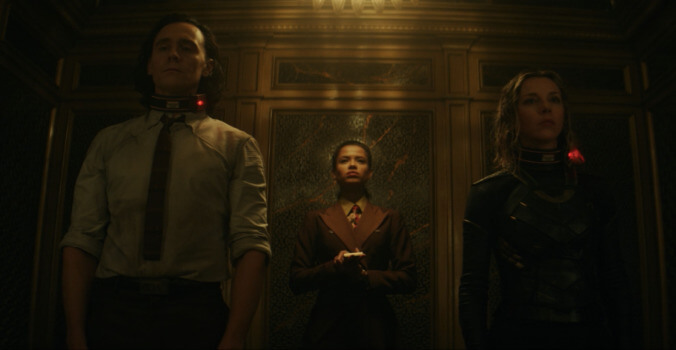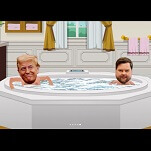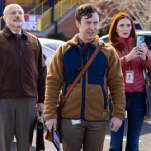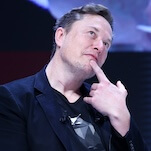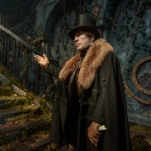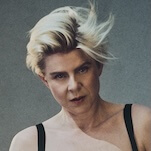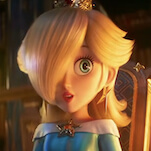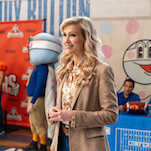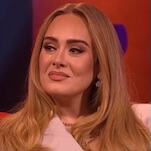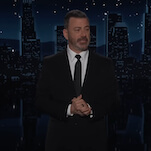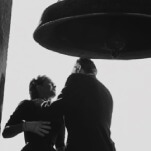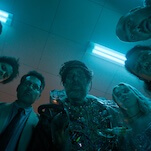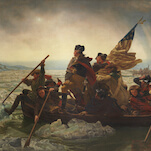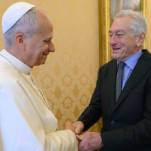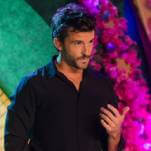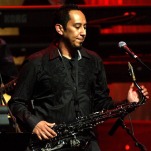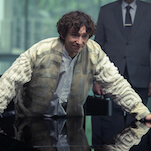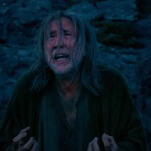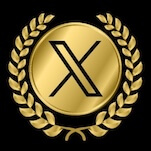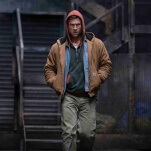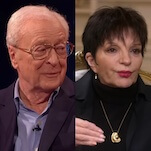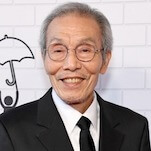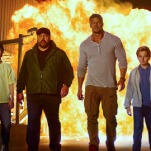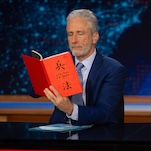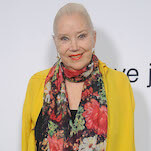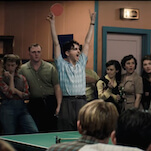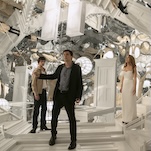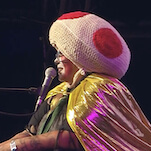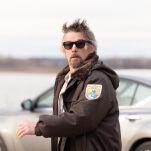ADA: We have a lot of scenes in the Time Theater, and I think as a DP, you don’t want people to get bored. Each scene is special on its own page, but you also want to keep it interesting and new whenever you’re cutting back to it. So we looked at a lot of that stuff and Kate, the AD, and me would go in prior to the shoot day and think about the blocking of the scene. I pitched them ideas—I’m a big fan of moving the camera around, and I have a great team as far as my gaffer and my operator. Adjusting lighting for the mood and the character, that’s always fun for me. In prep, we decided that we wanted the light in the time theater to move. So if you watch closely, you can see sometimes that the sun above coming through the ceiling moves on their shoulders, and the camera moves as well. There’s a shot in the armory where I do this circular dolly track around B15 and Mobius and Loki when they’re about to go to Roxxcart. Kate did a great job in the edit of finding those right moments. There’s some of those special moments when light and the camera have a nice energy and they kind of all coincide. That was all thought out in a way to make the scenes have more tension.
AVC: In the scene where Mobius is pruned, what direction did you get for shooting? Were you trying to catch as much of Tom’s reactions to what was happening with Owen’s character?
ADA: So when you have to block groups, you’ve got two options: People either walk in and stand in a spot, or they walk around. And in that scene, it plays well that [Renslayer’s team] is coming in and they’re confronting [Mobius and Loki]. We were blocking that, and it was more towards the end of those sequences we had had in the Time Theater, and we hadn’t really done a lot of framing towards the wall and we wanted to show the different sides. As they walk in with the Minutemen, we blocked them in a way that it looks like they’re in formation. It’s just a lot of symmetry; I like to center punch. We’re using an anamorphic format, so it’s important to me to have the right look in where people are standing. That’s how that scene evolved; I remember it clearly, because it was kind of towards the end of the group shots we were doing in there and trying to make that one feel interesting but work for the story. I think because they’re more of a team now, they’re kind of buddied up in a two shot together. They’re placed together like that, whereas Renslayer’s kind of toe-to-toe with them, like a Western.
AVC: Because this is a Marvel show, there are a lot of fight scenes, but one of my favorites was watching Loki and Sylvie, back-to-back, take on the fake Time-Keepers. That scene’s much more tactical; there’s a lot of hand-to-hand combat. How long did it take to get that right?
ADA: We have the stunt coordinator and her team who are always working on interesting sequences for what’s on the page. Kate worked with them a lot on each of those fight sequences and they would present to us what they had, showing us some previews of that, so that evolved into what you saw there. But as far as that back-to-back positioning, I do recall Kate really wanted them to feel like a team. They’re on the same side at that point, trying to get out of that mess. And then fast forwarding to that actual space, there’s a lot of VFX extension on that space, but it’s a great design that Kasra [Farahani, Loki’s production designer came up with. It looks as though it just goes on for infinity, the room replicates itself in distance. You’re getting a lot of depth and texture. On the day, that was a lot of blue screen on each side, but seeing his renderings are really exciting because I knew that in a final product, it was going to look very interesting. I love rooms that have a lot of texture and smoke, and we had a lot of haze there. My gaffer and I, we did some tests with production design prior about the colors in that space and the two-tone, where you got the cyan-y color and that kind of pink color, which is really beautiful.
I don’t recall how many days we had to shoot that, but anytime we had to shoot the fight sequence, we were always short. But you do your best. You get the hang of it and the key points are to be able to tell the story, but also get as much of the great choreographed action as you can. We did have some second unit cleanup that they do with the stunt players, which is amazing so that you have a little bit more of a time when they go in and do that after the fact. But I think that scene turned out really cool. It looks really beautiful. I love the light in that space and my gaffer and his team did a great job and then Kasra, his sets are just so brilliant.
AVC: There was a lot of discussion earlier this year over something Kevin Feige said after seeing some of the footage from The Eternals—he described being in awe of what could be accomplished more practically with a camera, which seemed to speak to how much VFX are used in superhero productions. As a cinematographer and someone who’s worked with green screens, how do you see the VFX working together with the practical shoots?
ADA: The thing with using a green screen or blue screen, or even black, or doing any roto work is all of the parties involved have to be on the same page and discuss what is needed for the final outcome. If I’m shooting something on set and there’s a blue screen behind the set, I need to know what’s going to be put there, because we want to make sure that we have a sense of what that light is going to ultimately end up being. The more information that I have about what’s going to be put back there, the better off it’s going to be when it’s comped together. That’s when the most successful shots happen, because the background is working with the foreground. Maybe we shot the foreground five months before the background was put in, but we all had a conversation about it and it ended up being what’s finally there.
For instance, episode one of Loki, he’s in the desert. We weren’t really in a desert. Some of that was a blue screen and then they put some of those backgrounds in. If we work together, that’s going to ultimately look better, and if it looks better then it feels more real. It’s really a conversation with a lot of homework, working closely with the effects team. This was the biggest project I’ve done with that element in it. But it’s just another tool to have, learn about, and try to be successful in. I don’t feel like if there’s a lot of blue screen, it’s a problem. As much as we can do in-camera and build, great; but if we can’t fly to Iceland, then we have to figure out how to make this look as best as it can. That’s a challenge in itself–and challenges are good.
There are a lot of films that you wouldn’t think have VFX. Zodiac actually has a good amount of blue screen in it. David Fincher’s a genius, and that film, Zodiac, feels just as real as it could feel to me. There are some elements in there that are VFX, but they’re done in the right way that doesn’t take an audience out. That’s really the trick. You do stuff in post to help drive the story forward because sometimes you just can’t do it in camera. That’s a collaboration.
